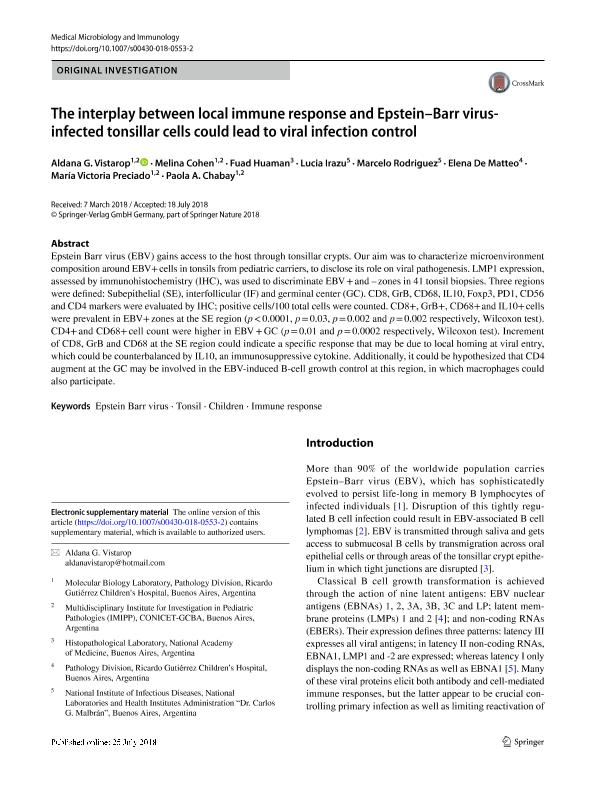Artículo
The interplay between local immune response and Epstein–Barr virus-infected tonsillar cells could lead to viral infection control
Vistarop, Aldana Georgina ; Cohen, Melina
; Cohen, Melina ; Huaman, Fuad; Irazu, Lucia; Rodriguez, Marcelo; de Matteo, Elena Noemí
; Huaman, Fuad; Irazu, Lucia; Rodriguez, Marcelo; de Matteo, Elena Noemí ; Preciado, María Victoria
; Preciado, María Victoria ; Chabay, Paola Andrea
; Chabay, Paola Andrea
 ; Cohen, Melina
; Cohen, Melina ; Huaman, Fuad; Irazu, Lucia; Rodriguez, Marcelo; de Matteo, Elena Noemí
; Huaman, Fuad; Irazu, Lucia; Rodriguez, Marcelo; de Matteo, Elena Noemí ; Preciado, María Victoria
; Preciado, María Victoria ; Chabay, Paola Andrea
; Chabay, Paola Andrea
Fecha de publicación:
07/2018
Editorial:
Springer
Revista:
Medical Microbiology and Immunology
ISSN:
0300-8584
Idioma:
Inglés
Tipo de recurso:
Artículo publicado
Clasificación temática:
Resumen
Epstein Barr virus (EBV) gains access to the host through tonsillar crypts. Our aim was to characterize microenvironment composition around EBV+ cells in tonsils from pediatric carriers, to disclose its role on viral pathogenesis. LMP1 expression, assessed by immunohistochemistry (IHC), was used to discriminate EBV + and – zones in 41 tonsil biopsies. Three regions were defined: Subepithelial (SE), interfollicular (IF) and germinal center (GC). CD8, GrB, CD68, IL10, Foxp3, PD1, CD56 and CD4 markers were evaluated by IHC; positive cells/100 total cells were counted. CD8+, GrB+, CD68+ and IL10+ cells were prevalent in EBV+ zones at the SE region (p < 0.0001, p = 0.03, p = 0.002 and p = 0.002 respectively, Wilcoxon test). CD4+ and CD68+ cell count were higher in EBV + GC (p = 0.01 and p = 0.0002 respectively, Wilcoxon test). Increment of CD8, GrB and CD68 at the SE region could indicate a specific response that may be due to local homing at viral entry, which could be counterbalanced by IL10, an immunosuppressive cytokine. Additionally, it could be hypothesized that CD4 augment at the GC may be involved in the EBV-induced B-cell growth control at this region, in which macrophages could also participate.
Palabras clave:
CHILDREN
,
EPSTEIN BARR VIRUS
,
IMMUNE RESPONSE
,
TONSIL
Archivos asociados
Licencia
Identificadores
Colecciones
Articulos(IMIPP)
Articulos de INSTITUTO MULTIDISCIPLINARIO DE INVESTIGACIONES EN PATOLOGIAS PEDIATRICAS
Articulos de INSTITUTO MULTIDISCIPLINARIO DE INVESTIGACIONES EN PATOLOGIAS PEDIATRICAS
Citación
Vistarop, Aldana Georgina; Cohen, Melina; Huaman, Fuad; Irazu, Lucia; Rodriguez, Marcelo; et al.; The interplay between local immune response and Epstein–Barr virus-infected tonsillar cells could lead to viral infection control; Springer; Medical Microbiology and Immunology; 207; 5-6; 7-2018; 319-327
Compartir
Altmétricas



